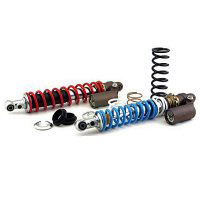A Works Performance Single-Rate Spring (SRS) has the same linear, or continuous (straight) spring rate throughout its compressed length. It is evenly wound, (constant pitch), to give it a linear spring rate. Spring rate is described by force, in pounds or kilograms, needed to compress the spring one inch or centimeter. A 125 lb. spring at 4 inches long will deflect (compress) one inch (to a 3 inch length) when 125 pounds of force is applied. To compress the same spring an additional inch would take an additional 125 pounds. This rate does not vary throughout the useful range of movement of the spring, until the spring binds, (coils touch each other), and cannot compress any more. In many short shock applications, a Single-Rate Spring is all that can be installed.
Works Performance Dual-Rate Springs (DRS) have two linear (straight) rate springs: a short spring with a "stiff" linear (straight) rate and a longer second spring with a "soft" linear (straight) rate. As both springs compress they result in a soft, or initial rate. The spring set will retain this initial rate until the short spring stops compressing. At that point, the spring rate "crosses over", (transitions), to the stiffer, or final, rate. On Works Performance shocks, this "crossover" point is set by means of crossover spacers, or with an ARS option. By adding or removing "crossover spacers", the rate can get stiffer sooner, or stay softer longer. The ARS option allows the rider to select the "crossover" point with a lever. The application of Single-, Dual- or Triple-Rate Springs is based on the overall length of the shocks, the shaft travel, and the available spring rates. Customer requirements also make a difference.
Works Performance Triple-Rate Springs (TRS) add a third "medium" linear (straight) rate spring in between.
A Progressive spring is not the same as a Dual-Rate Spring. A progressive-wound spring is similar to a dual-rate in that it has an initial and final rate. The drawback of a progressive spring is that the crossover point is not adjustable. How the spring is wound determines the characteristics of the spring. This type of spring is wound with a varying pitch, as opposed to a constant pitch used in linear rate springs. One end has greater distance between the coils than at the other end of the spring. As the coils compress the coils closest to each other touch, (become coil-bound), which effectively reduces the number of active coils. As the number of active coils reduce the spring rate rises or becomes stiffer. Depending on shaft travel of a particular shock, an inappropriate progressive spring can actually cross over the initial rate in pre-load, or not attain the final rate at all. Progressive-wound springs can be a compromise if they are not designed for the specific application. |
























































